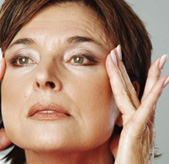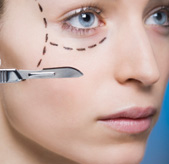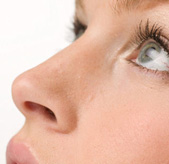Face Lifting (Rhytidoplasty)
 This surgery is designed to facial rejuvenation and therefore is responsible for reducing the signs produced by the time and gravity trough muscular action in the skin of the face, upper eyelid and neck.
This surgery is designed to facial rejuvenation and therefore is responsible for reducing the signs produced by the time and gravity trough muscular action in the skin of the face, upper eyelid and neck.
The main purpose of cosmetic surgery is to give the patient a more youthful appearance, softening the effects of skin aging like wrinkles and sagging, avoiding an artificial result or operated face stigma.
The facelift is divided into three types of surgeries:
1.Front Facelift or upper third of the face lifting
2.Facelift of the middle third of the face
3.Facelift of the lower third of the face or Cervicofacial Lifting
The treatment of deep structures of the face (SMAS, muscles) is essential to preserve facial structure and maintain the natural expressions of the same. Is a common practice to associate Blepharoplasty with Face Lift and Liposuction of fat in the submental region (under the chin area) when the case so warrants.
The candidates:
In general, Men and women over 40 years.
Blepharoplasty (Eyelids)
 This surgery aims to correct the function, form and aesthetics of the eyelids, providing a youthful and rested appearance to them.
This surgery aims to correct the function, form and aesthetics of the eyelids, providing a youthful and rested appearance to them.
A typical phenomenon in the eyelid is the emergence of “fat pockets” in both upper and lower eyelids. This change is caused by a herniated or bulging of the fat that is usually located around the eyeballs out of their place of origin. It is important to know that in many cases patients also have a few eyebrows that can accentuate the deformity of the upper eyelid.
It is vitally important ophthalmologic examination prior to surgery to evaluate the visual field and rule out other eye diseases.
Rhinoplasty (Nose)
 This surgery helps to improve the shape, size, symmetry and function of the nose, while maintaining harmony with the rest of the face.
This surgery helps to improve the shape, size, symmetry and function of the nose, while maintaining harmony with the rest of the face.
There are 2 types of approaches: closed and open.
Closed rhinoplasty: incisions are made here in the nasal mucosa and through her internal structures are exposed to later modify them according to the needs of each patient without apparent scarring.
Open rhinoplasty: An incision is made in the columella (tissue separating the nostrils) to visualize the internal structures that make up the nose and to modify them according to the needs of each patient.
It is indicated in more complex cases or in secondary and tertiary rhinoplasty.
This is a difficult to perform surgery and requires great sensitivity and skill. It is important to know that every person is different so you must make an accurate diagnosis of each nose, knowing the skin type (thick), if any alteration of the nasal bones, the cartilages, functional disorders that compromise breathing, genetic or racial characteristics. Thus be able to give each patient an personal and ideal.
Otoplasty (Ears)
 The Abano ear deformity is the most common of all birth defects of the ear. This can be noticed at birth and generally worsens over time.
The Abano ear deformity is the most common of all birth defects of the ear. This can be noticed at birth and generally worsens over time.
Surgery involves correcting the anterior projection of the ear, reducing the angle between the head and ear (cefaloauricular angle), escafoconchal angle and in some cases you must create a natural crease called anti-helix, and usually absent in this type of deformity.
The ideal age for surgery is from 5 years old and probably still has not developed any psychological trauma jokes product of their classmates.
This is an outpatient surgery is performed under general anesthesia in children and adults with local anesthesia and sedation
